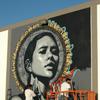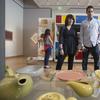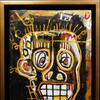The Studio of Nature
- November 16, 2011 17:13


For the Hudson River School artists there was no more sacred place than Kaaterskill Clove, the rocky, forested nave into which Thomas Cole and successive aspirants trekked and clambered, paint box and umbrella in hand.
The artists rarely came alone. Working in twos or threes outdoors in nature, they probably talked art, shared tips and encouragement, or sometimes just painted together in silence, listening to what William Cullen Bryant referred to as the "still voice" coming from "Earth and her waters, and the depths of air."
Today that "still voice" speaks to a new generation of young artists who are reinvigorating the traditions established by Cole, Durand and their followers. Calling themselves "The Hudson River Fellowship," the group spends several weeks each summer painting and sketching in the footsteps of their 19th century counterparts.
An offshoot of The Grand Central Academy in New York, the Hudson River Fellowship offers successful applicants the opportunity to immerse themselves in study alongside experienced artists surrounded by the inspirational blend of nature and history in and around Kaaterskill Clove.
The philosophy of the Fellowship, according to their website, is to "build a new movement of American art, modeling itself after the artistic, social and spiritual values of the Hudson River School painters. It will bring together the reawakening enthusiasm for the old American painters, the vigorous but unfocused scene of contemporary landscape painting and the urgent need for a renewed reverence for the land."
Lauren Sansaricq is a landscape artist who has spent the last three summers with the Fellowship. "It is extremely valuable for a landscape painter to spend time intensely studying nature," she explains. "The Hudson River School artists believed that nature could be a portal to higher spiritual and philosophical thought."
Back then, the artistic study of nature was frequently a rustic endeavor. The hotels along the rim of the Clove—now long gone—could be crowded, touristy, and beyond the frugal means of a struggling painter. Often, artists sought the hospitality of the locals.
Worthington Whittredge described one such location deep in the Cove: "This house, scarcely large enough to hold a family, was, nevertheless, for many summers the abiding place of a congregation of artists. The beds were few...the most expensive were composed of straw, while the cheapest were of feathers. As may well be imagined, the table at this house was not very good."
Today, the congregation of Fellowship artists lodges in comfortable homes nearby. There the artists can review each other’s work, listen to lectures, or page through "a huge stack of art books on the kitchen table." "The atmosphere was very communal," according to Sansaricq. "We all shared the same kitchen, and had breakfast and dinner at about the same time."
Daylight hours are spent outside. Out the door early, the artists carpool and hike to the spots that the Hudson River School painters made famous. Emphasis is not just on beautiful views, but also on close study of natural details—rocks, clouds, and trees—in what Asher Durand referred to as "the studio of Nature" in his "Letters on Landscape Painting" published in the Crayon in 1855.
At the end of the day, the artists regroup. "It has been a tradition every year that many of the fellows paint the sunset together, at what we call 'the sunset spot,'" relates Sansaricq. "This particular location has a great vast view of the sky and horizon, and really is a great location to study the light, color and atmospheric conditions of sunset."
Sansaricq’s work, including landscapes painted with the Hudson River Fellowship, is on view in the exhibition Nature’s Poetry: The Paintings of Lauren Sansaricq, through January 13 at Hawthorne Fine Art in New York. The exhibition catalogue can be downloaded as a .pdf from the website, or ordered in hardcopy format.
One of the paintings, The Top of Kaaterskill Falls (above), shows the famous location where Spruce Creek plunges over two hundred feet into the Clove. Beside the creek, countless visitors have carved their names into the rocks. On one of the rocks, worn letters chiseled a century and a half ago silently spell "S. R. Gifford". Where a master American landscapist carved his name, new artists are making theirs.
Sources:

Baur, John I. H., ed. The Autobiography of Worthington Whittredge, 1820-1910. New York: Arno Press, 1969. p. 56.




















